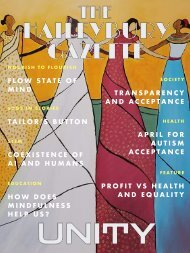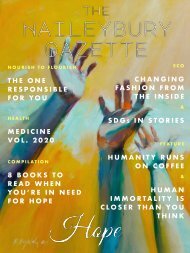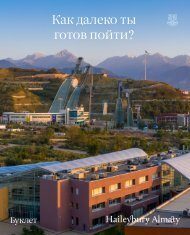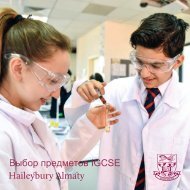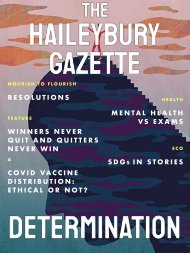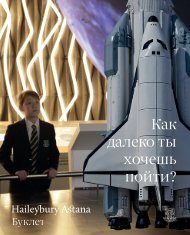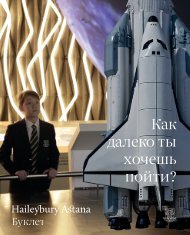Haileybury Gazette | Blooming|Issue 10
Create successful ePaper yourself
Turn your PDF publications into a flip-book with our unique Google optimized e-Paper software.
NOURISH TO FLOURISH<br />
DOPAMINE<br />
DETOX<br />
COMPILATION<br />
8 MOVIES ABOUT<br />
GROWING<br />
HEALTH<br />
NATURE IN MODERN<br />
MEDICINE<br />
EDUCATION<br />
HOW DID<br />
TECHNOLOGY<br />
CHANGE<br />
EDUCATION?<br />
ECO<br />
FOOD AND<br />
FASHION<br />
STEM<br />
FEATURE<br />
TAKE TIME TO<br />
SMELL ROSES<br />
MARS EXPLORATION<br />
WITH THE<br />
PERSEVERANCE<br />
ROVER
LETTER FROM THE EDITOR<br />
Ladies, gentlemen and non-binary folk,<br />
Spring has come and settled, and it is traditionally a time for reflections and hope. It is time to<br />
believe in yourself. You’re a force of nature, act like one.<br />
Strategize your vision and fulfil it. Take the risk. Why not? Allow yourself to bloom. Do not hold<br />
yourself back. The seed of potential is sowed, so care for the fruit of your hard work and passion<br />
to grow.<br />
As Soen Nakagawa said, a Taiwanese-born Japanese rōshi and Zen Buddhist master in the<br />
Rinzai tradition, “All beings are flowers blossoming in a blossoming universe.” Your<br />
presence brings light and comfort to the world around you, and your pursuit of growth is<br />
admirable. Keep going.<br />
Everything blooms at its own time, so do not put pressure on yourself. Pat yourself on the head<br />
and continue on your path. In the vast universe, in this time-space continuum that we are lucky to<br />
experience, you matter (yes, this is indeed a bad physics pun. I figured, why not, right?).<br />
At the end of the day, you are you, moving at your own pace, acting upon your own vision. And<br />
I find that really beautiful.<br />
Love,<br />
Erko<br />
2
TABLE OF CONTENTS<br />
2<br />
3<br />
4-5<br />
6-8<br />
9-11<br />
12-13<br />
14-16<br />
17-19<br />
20-23<br />
LETTER FROM THE EDITOR<br />
TABLE OF CONTENTS<br />
NOURISH TO FLOURISH: DOPAMINE DETOX<br />
EDUCATION: HOW DID TECHNOLOGY<br />
CHANGED EDUCATION<br />
COMPILATION: 8 MOVIES ABOUT GROWING<br />
ECO: FOOD AND FASHION<br />
HEALTH: NATURE IN MODERN MEDICINE<br />
STEM: MARS EXPLORATION WITH THE<br />
PERSEVERANCE ROVER<br />
HEALTH: BENEFITS OF GRATITUDE<br />
3
DOPAMINE DETOX<br />
NOURISH<br />
TO<br />
FLOURISH<br />
BY ANUAR K<br />
Ken Dodd, a world-renowned comedian, singer, actor,<br />
once boldly proclaimed, “happiness, happiness, the<br />
greatest gift that I possess!” To this day, many<br />
would agree with Ken, that at the end of the day,<br />
happiness is the ultimate goal of our lives. But what<br />
exactly is happiness? It’s a tricky subject, but most<br />
scientists would agree that the feeling of happiness is<br />
created by chemicals in our brains such as endorphins, serotonin, oxytocin and dopamine.<br />
Usually, when we experience ‘happiness’, that means we are releasing one of the<br />
aforementioned chemicals in our brain.<br />
Back in the forager days of the homo sapiens, when we used to roam in unorganized bands<br />
of people searching for food, everything we did was governed by dopamine. For every<br />
activity necessary for our survival: eating, drinking, reproducing, we received dopamine. This<br />
is why for example, after a long run, some nice cold water feels so satisfying. Our brains<br />
are engineered to reward us for activities that are beneficial for us.<br />
But this system is not always reliable. The laws that modern economics state that the<br />
more supply of a good, the less demand for said good. This strangely also applies to<br />
dopamine. When you receive too much dopamine, it is no longer that valuable.<br />
Unfortunately in the 21st century, acquiring said dopamine is way too easy.<br />
Imagine you are scrolling on your phone, whilst<br />
snacking away on some junk food, and at the<br />
same time listening to a podcast. You are doing 3<br />
things simultaneously that are supposed to give<br />
you dopamine. Yet somehow you are still not<br />
satisfied. This is overstimulation — a trap that so<br />
many people unknowingly fall in. Due to this<br />
phenomena, it can be incredibly hard to focus and<br />
accomplish even the most basic tasks. If you ever<br />
found it difficult to perhaps finish your homework,<br />
or wash the dishes, it could be partially credited to<br />
overstimulation.<br />
4
In the past, most people did not have access to so much dopamine at such easy costs. But the<br />
comfortability of modern life means that we can easily indulge in so many privileges with<br />
minimal restrictions. So this leads to overstimulation, a state where we consume so much<br />
‘happy chemicals’ that they no longer hold their value. In turn, we can no longer concentrate<br />
on activities that are important, but don’t give us much dopamine.<br />
So how do we go about solving this issue? Many people have championed the idea of a<br />
‘dopamine detox’. The main idea is to let go of almost all things that give us dopamine<br />
for one day. It doesn’t just mean stop watching Netflix or quit video games, it means letting<br />
go of ALL activities that give dopamine. This means no eating, no drinking, no reading, no<br />
working out, not even engaging in activities that are productive. You must sit in silence and<br />
meditate all day.<br />
However, dopamine detox in this extreme is unlikely to be very beneficial. At its core though,<br />
the dopamine detox is not a bad idea. But letting go of all activities that make us happy is<br />
very unnecessary. Instead simply quitting the things that are bad for us — be it our favourite<br />
video games or tv shows — for one day, can help you with combatting overstimulation.<br />
For example, no social media for a day. If<br />
you spend too much time scrolling through<br />
Instagram’s endless feed, then perhaps this is<br />
the right challenge for you. You will learn to<br />
resist the superficial desires, and next time<br />
you are tempted to open the app in spite of<br />
your responsibilities, you will make the right<br />
decision. This of course, is not limited to social<br />
media. Everyone is different, so these<br />
activities will differ from people to people. But<br />
once you realize what it is that overstimulates<br />
you, quitting for a day or two, may be<br />
extremely beneficial.<br />
So in conclusion, during overstimulation, it may seem almost impossible to overcome this lack<br />
of focus and willpower. There are a variety of different remedies such as the dopamine<br />
detox. However, this process will require an immense amount of self control, and instead a<br />
more safe and tame approach can be more beneficial. Quit whatever habit that plagues your<br />
life for just one day. No longer overstimulated, you will be able to concentrate and take back<br />
the reins of your life.<br />
5
HOW DID TECHNOLOGY<br />
CHANGE EDUCATION?<br />
BY AIDANA A<br />
EDUCATION<br />
The world has become progressive and modern through innovation. Technology appears to<br />
grow more and more each day, as it extends with every person, every click, and every<br />
touch. Thus, It has impacted essentially every aspect of our lives. And education is no<br />
exception.<br />
Even though if we look at the illustration of<br />
the 14th century that was done by<br />
Laurentius de Voltolina, we will still see how<br />
similar it is to the modern-day. The teacher<br />
is at the front, lecturing the lesson, while the<br />
students sit and listen. Some of them have<br />
their books open, some appear to be<br />
bored. The classrooms today do not look<br />
very different, however, you may discover<br />
current students have their tablets, mobile<br />
phones, laptops being open rather than<br />
books. It may seem that the education<br />
system stayed the same, however, the use of<br />
technology has fundamentally altered<br />
education in many ways.<br />
Access to learning opportunities today is exceptional in scope because of technology.<br />
Technology has significantly broadened access to education. During medieval times, books<br />
were rare and only an elite had educational opportunities. However, today there are<br />
enormous measures of books, data accessible to any individual who simply types in an<br />
inquiry in the Google search. Indeed, even conventional learning openings are accessible<br />
online worldwide through Khan Academy, MOOCs, and customary online degree programs.<br />
Moreover, students with learning disabilities such as being hearing impaired, partially blind<br />
or dislexyc have access to education through the use of technology. Because of it, any<br />
student gets an equal chance to explore, learn and be inquisitive about the world.<br />
6
WHAT IS EDUCATIONAL TECHNOLOGY?<br />
Education technology is “a field of study that investigates the process of analysing,<br />
designing, implementing, and evaluating the instructional environment and learning<br />
materials/technology to improve teaching and learning.” Its main purpose is to use<br />
technology and knowledge to design the most effective learning environment for students. By<br />
using technology teachers are able to create digital, interactive textbooks, gamify lessons,<br />
take attendance, assign homework, hold quizzes and tests, and more.<br />
Here are some examples of educational technology:<br />
1. AUGMENTED REALITY AND VIRTUAL<br />
REALITY<br />
According to Daniel Newman, a technology<br />
innovation specialist, “augmented, virtual and mixed<br />
reality are examples of transformative technology that<br />
enhance teacher instruction while simultaneously<br />
creating immersive lessons that are fun and engaging<br />
for the student”. Virtual reality is able to bring the<br />
outside world into the classroom.<br />
2. ARTIFICIAL INTELLIGENCE<br />
People have anticipated that through 2021, artificial intelligence<br />
would turn into an essential part of education and develop over<br />
45%. One of its functions is that it can automate basic activities<br />
in education, for instance, grading. Teachers don’t have to<br />
waste time on marking tests as artificial intelligence does it<br />
automatically. For example, a language learning app,<br />
Duolingo, will assist students at their speed by showing them<br />
where their weaknesses and strengths are.<br />
7
3. GAMIFICATION<br />
If you are searching for an approach to<br />
transform learning into a more fun and<br />
engaging process, gamification is the<br />
answer. Students can learn and practice<br />
while they are participating in game<br />
exercises. Gaming elements help to<br />
establish an interesting and positive<br />
learning climate for students. A famous<br />
example is a program called Kahoot!, a<br />
game-based learning and trivia platform.<br />
Technology is a powerful tool that can support and transform education in many ways. The<br />
COVID-19 pandemic has demonstrated why it is fundamental to integrate technology into<br />
existing educational plans. By utilizing technology in the classroom enables new ways of<br />
learning, communicating, and working collaboratively. Today teachers are more seen as “a<br />
guide” as students can take more responsibility for their learning using the internet to gather<br />
the information. As a result, they become aware of different perspectives and learn useful life<br />
skills through technology. As educational institutions are adapting to technologies, we must<br />
also remember about safety and security, and potential withdrawals technology may have.<br />
Hence, it is important to educate students on internet safety. Therefore, now is a great<br />
opportunity to improve and show the progress of educational technology.<br />
8
8 MOVIES ABOUT GROWTH<br />
BY ALIMA G<br />
COMPILATION<br />
Sometimes growing up can seem scary, but you have to remember that change is only<br />
natural and is a good thing as it is detrimental to one’s personal development. As you grow<br />
older, you start to establish yourself as a person; who you are and what you stand for.<br />
However, the journey of figuring that out is a long one, so don’t worry about not feeling sure<br />
as of now. Thankfully, one of the many art forms that can help us are movies, as they tell all<br />
kinds of stories and spread amazing messages - helping in all kinds of different aspects of our<br />
lives, including personal growth. We hope that the compilation of these movies about growth<br />
and personal development will inspire you.<br />
1. MOONLIGHT<br />
This movie about growing up different and finding your identity<br />
follows the life of a young Chiron struggling with figuring out his<br />
identity, while going through the everyday struggles of<br />
adolescence. We follow his life at different ages and stages of his<br />
life, so you can see how the places he finds empathy and kindness<br />
as a kid shape him as an adult.<br />
2. DEAD POETS SOCIETY<br />
A new English teacher in an all-boys preparatory school uses<br />
unorthodox methods to reach out to his students, who face<br />
enormous pressures from their parents and the school. With his<br />
help, the students learn to break out of their shells, pursue their<br />
dreams and seize the day. The movie purports to be about the<br />
bravery of following one's own path.<br />
9
3. HAPPY<br />
The movie takes the viewers on a journey from the swamps<br />
of Louisiana to the slums of Kolkata in search of what<br />
really makes people happy. It makes you rethink your<br />
perspective on many things and you will find yourself<br />
asking ‘What is it that brings me happiness in my life?”.<br />
4. BOYHOOD<br />
The movie is a daring film experiment, as it is one of the few films<br />
where you actually get to see the star grow up before your eyes<br />
in real life over a period of 12 years, from a little kid to a young<br />
adult as you follow his experiences through childhood and<br />
adolescence. It’s a bold construct for the most common of life<br />
experiences and a story that comes to the simplest of conclusions,<br />
that what matters most in life is being present, as the small<br />
moments are just as important as the big ones.<br />
5.GOOD WILL HUNTING<br />
Will Hunting works as a janitor at M.I.T., but has a gift for<br />
mathematics. A headstrong, working-class genius, he is failing<br />
the lessons of life and has one too many run-ins with the law.<br />
A psychology professor seems to be the only man who can<br />
reach him - helping him find direction in his life.<br />
<strong>10</strong>
6. A BEAUTIFUL MIND<br />
This movie about personal growth is the story of John Forbes Nash<br />
Jr., an eccentric math genius who also suffers from schizophrenia.<br />
The protagonist deals with this disease while developing a<br />
mathematical theory that revolutionizes many fields of science.<br />
Through perspective the movie offers on mental health, we see the<br />
resilience of the main character as he learns to trust the people he<br />
loves.<br />
7. THE 15:17 TO<br />
PARIS<br />
The plot follows real life events of 3 heroic American passengers<br />
that leapt into action during a 2015 Thalys terrorist train attack.<br />
The narrative will motivate you to stand up for what's right -<br />
always, no matter the cost.<br />
8. THE INTOUCHABLES<br />
This movie follows the unlikely, close friendship of a Parisian<br />
aristocrat, who becomes a quadriplegic after a paragliding<br />
accident and a young man, hired to be his live-in caretaker.<br />
The two drastically change each other’s lives, challenging<br />
one another to get out of their comfort zones and simply do<br />
better.<br />
We hope that you will enjoy watching these movies, as it is<br />
experiencing different stories and viewing different<br />
perspectives that ignites new ideas for your self-improvement<br />
and developing into the best version of yourself.<br />
11
FOOD AND FASHION<br />
ECO<br />
WE ALL NEED TO EAT AND WE ALL NEED CLOTHES TO WEAR!<br />
But how we make, consume and discard food and textiles can have a<br />
huge environmental footprint.<br />
A whole month of learning in all subjects will culminate in an exciting themed week and<br />
a great finale on Friday 23rd April -<br />
‘THE Revamp Designer Show/Exhibition’<br />
where we all will share our projects and take pledges towards a more sustainable life!<br />
For all you budding designers out there:<br />
Design and make an outfit, accessories, installations, art work at home or in school using<br />
recycled materials for a fantastic<br />
RESPONSIBLE CATWALK/Exhibition!<br />
Real Life Designers from FASHION REVOLUTION KAZAKHSTAN will judge<br />
on the most thoughtful entries.<br />
For more information contact our Sustainability Coordinator, Mrs Jacoby<br />
(a.jacoby@haileyburyalmaty.kz)<br />
or our Eco School Coordinator, Mrs. Neylon<br />
(c.neylon@haileyburyalmaty.kz)<br />
12
13
NATURE IN MODERN<br />
MEDICINE<br />
HEALTH<br />
BY ALIYA B<br />
When we think of medicine, we tend to imagine large, high-tech labs and robots synthesising<br />
compounds. While it is true that technology and modern advancements help the medical field<br />
greatly, most of the compounds are derived from none other than Mother Nature herself.<br />
Indeed, “Scientific American” has published that over half of all pharmaceutical drugs in<br />
use today come from natural sources. Morphine, cocaine, aspirin and penicillin are just 4<br />
that are covered in this article out of the numerous drugs found in all kinds of rainforests and<br />
deserts, oceans and ice caps, on Earth.<br />
MORPHINE<br />
Morphine is a strong painkiller that is often used for<br />
surgeries or prescribed to those suffering from heart<br />
attacks and cancer-related pain. In the brain,<br />
morphine releases dopamine, a “feel-good”<br />
hormone that blocks pain signals and makes you feel<br />
content. After first being discovered in 1803,<br />
morphine quickly became widespread during the<br />
American Civil War of the 1860s. Many even blame<br />
the war for being a catalyst to drug abuse and<br />
addiction that is prevalent today.<br />
Morphine, along with other narcotics like heroin and codeine, comes from the opium<br />
poppy. The plant flourishes in dry, warm climates; notably in countries like Burma,<br />
Afghanistan, Tasmania and Colombia. The earliest reference to opium poppies is from 3,400<br />
BC. Sumerians, who lived in Mesopotamia (modern-day Iraq), referred to them as “joy<br />
plants”.<br />
14
COCAINE<br />
Although cocaine is typically associated<br />
with drug abuse, it in fact has legitimate<br />
medical uses as well. Cocaine is a valuable<br />
anaesthetic that also has significant<br />
vasoconstricting properties (i.e. it can<br />
constrict blood vessels). That is why some<br />
physicians around the world use cocaine to<br />
treat nosebleeds.<br />
Cocaine is derived from coca leaves, mostly grown in South America. It is believed that<br />
ancient Incas in the Andes used to chew coca leaves in order to increase their heart rates to<br />
counteract the effects of living in the mountains. Coca leaves were so popular that a<br />
biochemist called John Pemberton included coca leaves as an ingredient in his new soft<br />
drink, which he called the “Coca-Cola”. Needless to say, that was back when cocaine was<br />
legal for recreational use.<br />
ASPIRIN<br />
Aspirin is a very common drug used to<br />
relieve pain, reduce fever and lower<br />
inflammation. It reduces blood clotting<br />
by working as a blood thinning drug.<br />
Aspirin can be bought without<br />
prescription, but it is highly advised not to<br />
be taken by individuals under 18 due to its<br />
connection to Reye’s syndrome - a<br />
condition involving brain damage in<br />
children.<br />
Although aspirin is technically a ‘synthetic’ drug, it turns into a ‘natural’ one after intake<br />
once it breaks down. Hippocrates, the famous physician of Ancient Greece, used to distribute<br />
willow leaf tea to patients. Willow trees are often planted in flooded areas since they can<br />
absorb large quantities of water. It is from the bark of willow trees that salicin, a compound<br />
of Aspirin, is derived.<br />
15
PENICILLIN<br />
Dating back to World War II, penicillin was crucial to saving millions of lives. So much so that<br />
1/7 of all wounded UK soldiers were saved by the antibiotic. Despite the fact that its<br />
discovery was truly game-changing to the medical field, penicillin was in fact discovered<br />
accidentally. In 1928, bacteriologist Alexander Fleming came back from vacation to find<br />
green mold growing all over his petri dishes, slowly killing off bacteria living in them.<br />
Penicillin was the first ever drug to effectively combat bacterial infections.<br />
Penicillium mold naturally produces<br />
penicillin. The mold typically grows on<br />
decaying organic material such as fruits<br />
and vegetables. Scientists use deep<br />
fermentation tanks to enhance the growth<br />
of the mold, from which they later on<br />
extract the antibiotic Penicillin itself. Some<br />
of the infections penicillin treats nowadays<br />
include meningitis, syphilis, pneumonia,<br />
strep throat and gonorrhea.<br />
In conclusion, when you combine the benefits of every single natural drug out there, it<br />
becomes crystal clear how great of a role nature has been playing in sustaining our health<br />
for millenia. From Sumerians living thousands of years BC to us living thousands of years AD,<br />
we owe much of what we have around us to the environment. As the season of blooming<br />
begins to unfold around us, let’s take a moment to thank nature for its incessant efforts that<br />
keep us alive, prosperous and healthy every single day!<br />
16
MARS EXPLORATION WITH<br />
THE PERSEVERANCE ROVER<br />
BY SELIN C<br />
S . T . E . M .<br />
From the rise of the space age, Mars has been the most prized target for astrobiological<br />
studies, being the most Earth-like planet in our solar system. With the landing of the<br />
Perseverance rover on February 18th, 2021, NASA has commenced its most aspirational<br />
effort to directly study whether there was ever life on the now cold and hostile red planet,<br />
opening the door to a monumental journey for humanity. This rover will act as a robotic<br />
geologist and a mobile astrobiologist, which will collect dirt and rock samples that will<br />
eventually be returned to Earth by the 2030s.<br />
The spacecraft launched in July and travelled for 292.5 million miles to arrive at Mars. The<br />
vehicle carrying Perseverance entered the Martian atmosphere at 12,000 mph, and it used a<br />
heat shield to avoid burning up. Then, it deployed a 70 foot diameter parachute while still<br />
going nearly twice the speed of sound. The craft finally used rocket thrusters to slow down<br />
further and after that a system known as a sky crane to lower the rover the final distance to<br />
the surface. Once, it arrived at Mars, the rover’s journey to the planet’s surface started with<br />
a bang which NASA calls the ‘seven minutes of terror.’<br />
17
The ‘seven minutes of terror’ refer to the entry, descent and landing phase of the rover<br />
as the events take place much quicker than the radio signals can reach Earth from Mars for<br />
communication. The engineers that overlooked the event for the Perseverance rover were<br />
unable to guide or direct the rover’s landing as it takes a while to establish or send any<br />
communication from Earth to Mars. Therefore, the rover performed a landing itself, without<br />
any human guidance. The ground teams simply told the spacecraft when to begin the entry,<br />
descent, and landing phase and the spacecraft took over from there. This was by far the most<br />
critical moment of the mission, as it was not guaranteed to be successful. Nevertheless,<br />
Perseverance had arrived safely on Mars.<br />
(Photograph taken on Mars by the Perseverance rover)<br />
Perseverance’s two year mission began at last, and it is currently going through a<br />
‘checkout’ period to make sure that it is ready. The rover will also find a nice, flat surface<br />
to drop the Ingenuity helicopter so that it has a place to use as a helipad for its potential five<br />
test flights during a 30 day period. This will occur within the first 50 to 90 sols, or Martian<br />
days, of the mission. Once Ingenuity is settled on the surface, Perseverance will drive to a<br />
secure place at a distance and use its cameras to watch Ingenuity’s flight, which will be<br />
the first flight of a helicopter on another planet. After these flights, the Perseverance rover<br />
will start searching for evidence of ancient life, study the climate and geology of<br />
Mars and collect samples that will be returned to Earth in future missions. It will drive<br />
three times the speed of previous rovers. The home of Perseverance will be the Jezero Crater<br />
because billions of years ago, the basin was the site of a lake and river delta.<br />
18
Rocks and dirt from this basin could provide fossilized evidence of past microbial life, as<br />
well as more in depth information about what the environment of ancient Mars was like.<br />
Seeing no signs of ancient life on Mars would strengthen the case that Earth is special. On<br />
the contrary, finding an independent origin of life on Mars would be compelling evidence for<br />
the notion that the universe is built for biology’s blossoming. Although most scientists suspect<br />
fossilized microbes to be the most advanced organisms we could discover at Mars, any<br />
existent life there, even if single-celled, would spur some to immediately leave Mars to the<br />
Martians. A seemingly sterile planet would in some ways be the most promising scenario for<br />
eventual human exploration and settlement there<br />
Mars Oxygen In-Situ Resource Utilisation Experiment (MOXIE)<br />
Perseverance also carries instruments that could help future exploration on Mars, such as the<br />
Mars Oxygen In-Situ Resource Utilisation Experiment (MOXIE). This experiment will attempt<br />
to convert the carbon dioxide on Mars into oxygen. This tool could help NASA<br />
scientists learn how to produce rocket fuel on Mars, as well as oxygen which could be used<br />
during future human exploration of the red planet.<br />
Ultimately, if the mission proves to be successful, it may act as a crucial turning point in Mars<br />
exploration. It could bridge the earlier findings or organics, water, and methane to more<br />
concrete evidence of life and habitability, and also serve as a herald for future human<br />
expeditions in the 2030s or 2040s.<br />
19
TAKE TIME TO SMELL THE<br />
ROSES<br />
BY ALIKSENIIA M<br />
FEATURE<br />
“If we could see the miracle of a single<br />
flower clearly our whole life would change.”<br />
- Buddha<br />
THE LANGUAGE OF<br />
FLOWERS:<br />
Not only are flowers beautiful additions to<br />
homes, weddings and special events, they<br />
also have different meanings attached to<br />
them. Flower language, also known as<br />
floriography, is the art of flower<br />
symbolism, which varies depending on the<br />
type, colour and number of flowers given.<br />
Although many credit the Turks for developing flower meanings in the 17th century, the<br />
language of flowers is most commonly associated with the Victorian era. It was during the<br />
reign of Queen Victoria (1837 - 1901) that flowers were used to communicate feelings that<br />
the strict etiquette of the era would not allow to be openly expressed.<br />
FLORIOGRAPHIC DICTIONARY:<br />
FLOWERS OF FRIENDSHIP<br />
• Yellow Rose - symbolise friendship and joy<br />
• Freesia - these delicate blooms show innocence<br />
and thoughtfulness<br />
20
• Stocks - a pretty flower meaning lasting beauty, a happy life<br />
and the bonds of affection - perfect for a best friend<br />
•Peruvian Lilies - this is a flower of friendship that also<br />
symbolises wealth, prosperity and fortune<br />
FLOWERS OF GRATITUDE<br />
• Pink Rose - pink roses are the perfect way to show gratitude,<br />
appreciation and admiration<br />
•Hydrangea - the hydrangea symbolizes gratitude for being<br />
understood. They represent anything that is sincerely heartfelt<br />
• Peach Rose - these roses represent modesty and demureness. They<br />
can also be given to show someone how much you are missing them<br />
FLOWERS OF JOY<br />
• Sunflower - represent positivity, strength, admiration and loyalty. In<br />
Chinese culture, sunflowers are said to mean good luck and lasting<br />
happiness which is why they are often given at graduations and at the<br />
start of a new business<br />
21
• Chrysanthemum- these beautiful blooms symbolise optimism, joy, and<br />
long life.<br />
• Daffodil - as one of the first signs of spring it's no surprise that daffodils<br />
represent rebirth, new beginnings and good fortune. Make sure you give<br />
them as a bunch because a single daffodil represents misfortune.<br />
•Pink Rose - the blush colour of these buds symbolises<br />
happiness, joy, gratitude and admiration.<br />
• Lily of the Valley - this delicate flower represents sweetness and purity<br />
• Pink Hyacinth - the pink blooms of the hyacinth symbolise playfulness<br />
• Yellow Tulip - these are given to reflect cheerfulness and sunshine, but it<br />
wasn’t always this way, yellow tulips used to mean hopeless love<br />
(Natasha Koroleva had a song about separation in love called “Yellow<br />
tulips” in the 90s)<br />
•Gerbera - these daisy-like flowers mean cheerfulness, loyal love,<br />
innocence and purity<br />
22
FLOWERS OF EMPATHY AND REMEMBRANCE<br />
• Poppy - they symbolise remembrance and consolation.<br />
• White Stargazer Lily - as a common funeral flower these lilies<br />
resemble purity, innocence and sympathy<br />
•Statice - given for remembrance and<br />
sympathy, but can also be a symbol of<br />
success.<br />
• Purple Hyacinth - purple hyacinths mean sorrow, forgiveness<br />
and regret<br />
• White Tulip - these flowers are used to show worthiness and to seek<br />
forgiveness, making them a great flower for when you’re trying to apologise<br />
FLOWERS OF LOVE AND ADMIRATION<br />
• Red Rose- the lover's rose, often associated with Valentine's<br />
Day, meaning enduring passion<br />
•Lavender Rose - this delicate colour of rose means enchantment and love<br />
at first sight<br />
23
• Dahlia - demonstrates the lasting bond and commitment between two<br />
people - great for anniversaries.<br />
•Red Tulip - tulips in general mean perfect love. Red tulips take this a<br />
step further and symbolise true love, so are an ideal gift for the love of<br />
your life.<br />
• Carnation - they stand for love, fascination and distinction but the<br />
colour you choose changes the meaning slightly:<br />
Light Red - admiration<br />
Dark Red - deep love and affection<br />
White- pure love and good luck<br />
Pink - a Mother's undying love<br />
• Sweet William - as one of the only flowers to symbolise<br />
masculinity, sweet william means gallantry<br />
OTHER FLOWERS<br />
• White Calla Lily - these lilies mean beauty, innocence,<br />
magnificence and purity<br />
•Iris - named after the Greek Goddess Iris, these flowers symbolise faith,<br />
hope and wisdom<br />
24
• Peony - peonies often represent prosperity, along with a happy life and<br />
marriage<br />
•Pink Stargazer Lily - these beautiful pink blooms show wealth,<br />
prosperity, honor and aspiration.<br />
• Anemone - there is quite a sad meaning associated with anemones. They<br />
show feeling forsaken or faded hope<br />
“There is a language, little known,<br />
Lovers claim it as their own.<br />
Its symbols smile upon the land,<br />
Wrought by nature’s wondrous hand;<br />
And in their silent beauty speak,<br />
Of life and joy, to those who seek<br />
For Love Divine and sunny hours<br />
In the language of the flowers.”<br />
- The Language of Flowers, London, 1875<br />
25
THE HAILEYBURY GAZETTE<br />
EDITORIAL TEAM<br />
Yerkezhan ‘Erko’ S (she/her) - Wonder Woman<br />
Editor-in-Chief, Managing Editor<br />
Head Girl<br />
Aidana A (she/her) - Bambi<br />
Writer, Reporter<br />
Y12 AKO<br />
Alima G (she/her) - Cupid<br />
Writer, Editor<br />
Y11 JOW<br />
Alikseniia M (she/her) - Olaf<br />
Writer, Feature<br />
Y11 KSST<br />
Anuar K (he/him) - Monke<br />
Writer, Columnist<br />
Y11 KSST<br />
Saduakas O (he/him) - Jewel Thief<br />
Designer<br />
Y11 DSC<br />
Aliya B (she/her) - Judy Hopps<br />
Writer, Profile<br />
Attlee Deputy House Captain<br />
Y12AKO<br />
Selin C (she/her) - Jo March<br />
Writer, STEM<br />
Edmonstone Social and Charity Captain<br />
Y11 ELWI<br />
26




